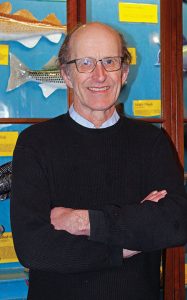Michael Moore, a senior scientist with the Woods Hole Oceanographic Institution (WHOI), recently gave an afterschool talk at the Marion Natural History Museum on “Whales of Our Region,” with a special focus on endangered right whales.
Turns out, the kids already knew a lot on the subject of whales. For instance, Moore asked what defines a mammal, and one boy knew the answer: Mammals give live birth to their young.
Moore shared photos of humpback whales, right whales, and minke whales, many taken with a drone named “Archie” that is also used to collect samples from whales’ blow clouds for analysis. The overhead photos provided impressive views of whales engaging in “bubble net feeding,” where they swim upward in a spiral while blowing bubbles that encircle bait fish like herring, which the whales then eat in a great gulp. They are then able to push the salt water from their mouths while straining their catch through baleen.
The overhead photos also illustrated how individual whales can be identified – right whales by the callosities on their lips, minke whales by their white arm bands, and humpbacks by the white patterns on the underside of their tails (not visible to drones) – and monitored.
Beyond exploring different species of whales, Moore also discussed challenges to their survival posed by humans boating and fishing.
“I’ve spent my life looking at the balance between human life and marine life,” Moore said. “There is always a cost and a benefit.”
The cost to whales has been, and continues to be, steep. There is the danger posed by fishing gear like lobster traps and the danger posed by ship strikes. Five percent of the right whales’ entire population died in 2017. If that rate of loss continues, Moore said, they will be extinct in 20 years’ time.
Not to leave anybody too glum, Moore did show one last overhead photo of a whale, um, relieving itself in the ocean. Nothing will perk up a child like talking about whale doody. Which happens to be a very good fertilizer for the ocean, which is good for the fish, which is good for the whales.
Or, as Moore more simply stated, we must “save the whales to save the fish.”
By Deina Zartman

